Nebulas
A Nebular is an interstellar cloud in outer space made up of dust, hydrogen, helium gas and plasma. These clouds are formed when portions of the interstellar medium collapses and clump together due to the gravitational attraction of the particles that comprises them.
Space isn’t quite an empty vacuum; there are gasses and clouds of dust and each particle has a gravitational force relative to the proportion of its mass. The more that clumps together the larger the gravitational attraction, as more clumps together to form a larger and larger structure, the pressure inside increases and once this is high enough, nuclear fusion begins resulting in the emission of high energy electromagnetic radiation, which then in turn ionizes the outer layers of gas.
What exactly is a light year?
A light-year is essentially the distance that light can travel in one year.
- One year = 31,536,000 seconds. Light covers a distance of 300,000 kilometres in a second.
- In one year light is capable of traveling (31,536,000 x 300,000) kilometres = 9,460,800,000,000 kilometres.
- Let’s hypothetically use a nebula of a perfect circle
- The maximum distance between two extreme points of the nebula will be its diameter.
- Let’s use a 1 light-year wide nebula; the diameter of the nebula would be 9,460,800,000,000 kilometres.
Fun Facts:
- Nebulas are a mixture of the gasses hydrogen and helium, as well as dust and plasma.
- The Image’s below of nebular where actually taken in black and white, researchers and scientists mix, shade and colour these images dependant on their chemical makeup
- The Word Nebula means ‘’Clouds’’ in Latin. Which is fitting due to their ‘misty’ and cloud like appearances.
- If you look closely enough, you can see the Orion Nebula near Orion’s belt. It looks like a tiny dot to the naked eye, even though it’s 60 light-years across.
- There are two means by which nebulae form. Nebulas are often the result of a giant star or a white dwarf going supernova. The Crab Nebula was formed by a supernova in the year 1054. This event was observed across many cultures during the time. Nebulae such as the Crab Nebula are proof that our universe is constantly changing. The other means by which a nebula can form is when the gas and dust in space (known as the interstellar medium) becomes so dense, it starts to be pulled in by gravity.
- Stars can be born inside nebulae, such The Crab Pulsar is an extremely young, spinning star, which emits radio waves. Because of its unique nature, changes in the Crab Nebula can be seen in a matter of days (1). This time scale is relatively short compared to the long life spans and slow growth of most celestial bodies. as the Crab Pulsar which resides within the Crab Nebula.
Mystic Mountain – Carina Nebula
The Mystic Mountain captures the chaotic activity atop a mountain of dust and gas rising in the Carina Nebula. The top of a three-light-year tall pillar of cool hydrogen is being worn away by the radiation of nearby stars, while stars within the pillar unleash jets of gas that stream from the peaks.
Distance: 7500 light-years away from Earth in the constellation Carina.
- High-res version: Link
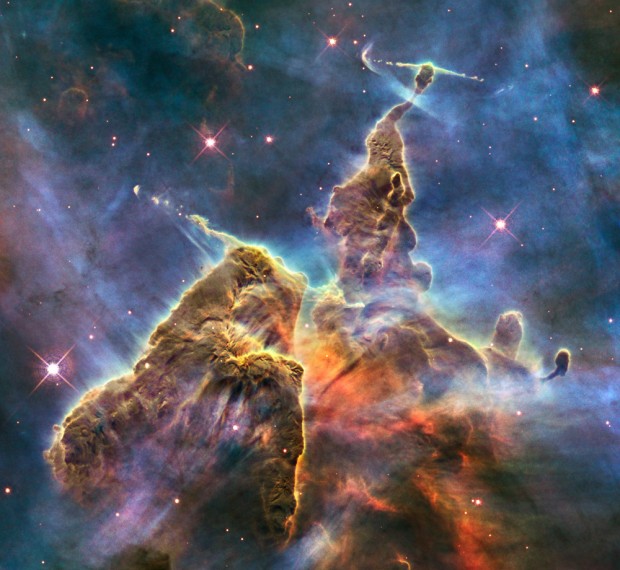
Image Source: NASA, ESA, and M. Livio and the Hubble 20th Anniversary Team (STScI)
Supernova Remnant – Veil Nebula
The Veil Nebula Supernova Remnant captures in stunning detail a small section of the expanding remains of a massive star that exploded about 8,000 years ago. This debris is one of the best-known supernova remnants covering a staggering 110 light-years across.
Distance: 2,100 light-years away in the constellation Cygnus.
- High-res version: Link
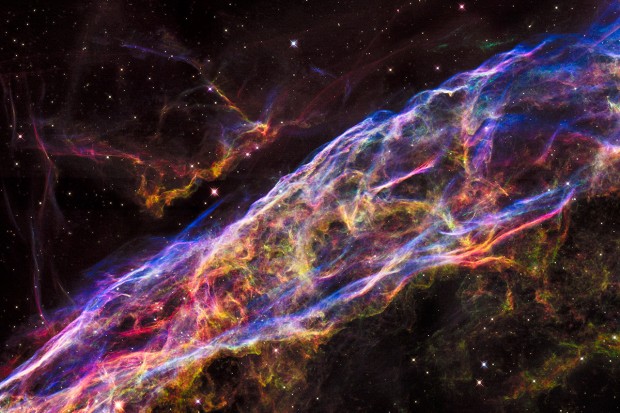
Image-Source: NASA, ESA, and the Hubble Heritage Team (STScI/AURA)
Gas Pillars – Eagle Nebula
The Eagle Nebula boasts this eerie dark pillar like structure, are columns of cool interstellar hydrogen gas and dust that are also the incubators for new stars. They are a part of the Eagle Nebula and as the pillars themselves are slowly eroded away by the ultraviolet light, small globules of even denser gas buried within the pillars are uncovered. These globules have been dubbed “EGGs.” Or “Evaporating Gaseous Globules’’
Distance: 6,500 light-years away in the constellation Serpens.
- High-res version: Link
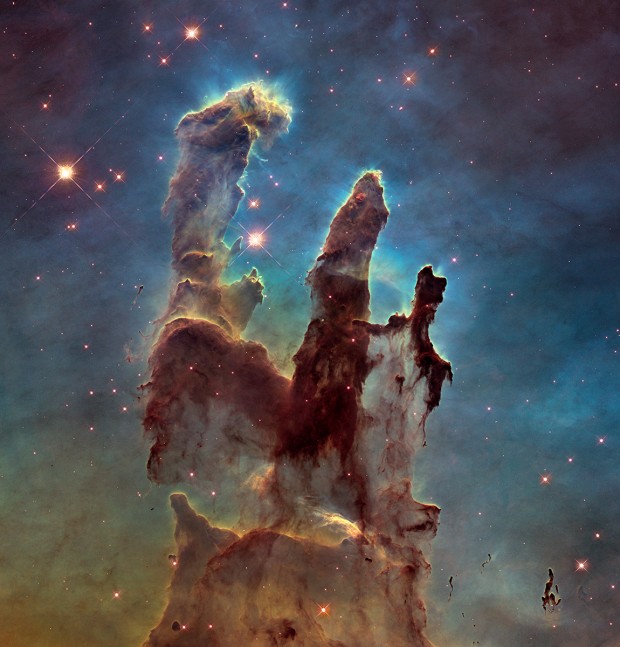
Image-source: NASA, ESA, and the Hubble Heritage Team (STScI/AURA)
Horsehead Nebula
The Horsehead Nebula as shown in infrared wavelength, the nebula appears transparent and ethereal, represented here with visible shades. The rich tapestry of the Horsehead Nebula pops out against the backdrop of Milky Way stars and distant galaxies that are easily seen in infrared light.
Distance: 1,500 light-years away in the constellation Orion.
- High-res version: Link
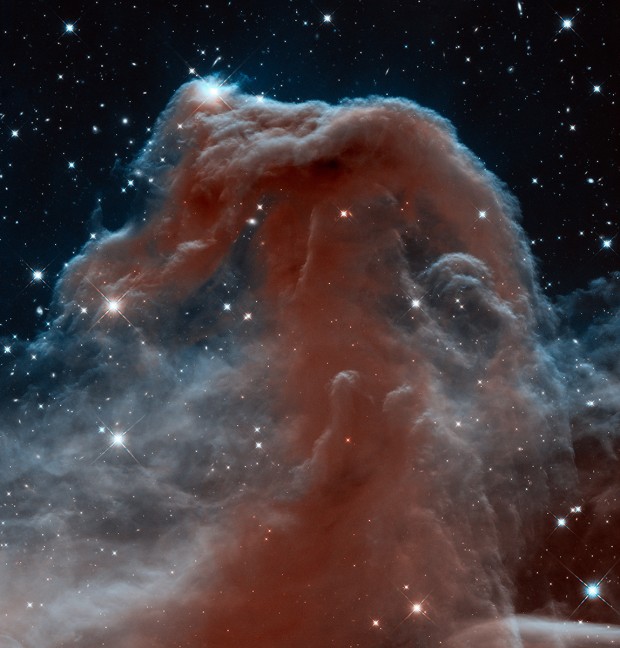
Image-source: NASA, ESA, and the Hubble Heritage Team (STScI/AURA)
Helix Nebula
This Nebula is so large that both the Hubble Space Telescope and the Mosaic II Camera on Earth had to be used to capture a complete view. The Helix Nebula is a planetary nebula, the glowing gaseous envelope expelled by a dying, sun-like star. The Helix resembles a simple doughnut as seen from Earth, but new evidence suggests that the Helix consists of two gaseous disks nearly perpendicular to each other.
Distance: 690 light-years away in the constellation Aquarius.
- High-res version: Link
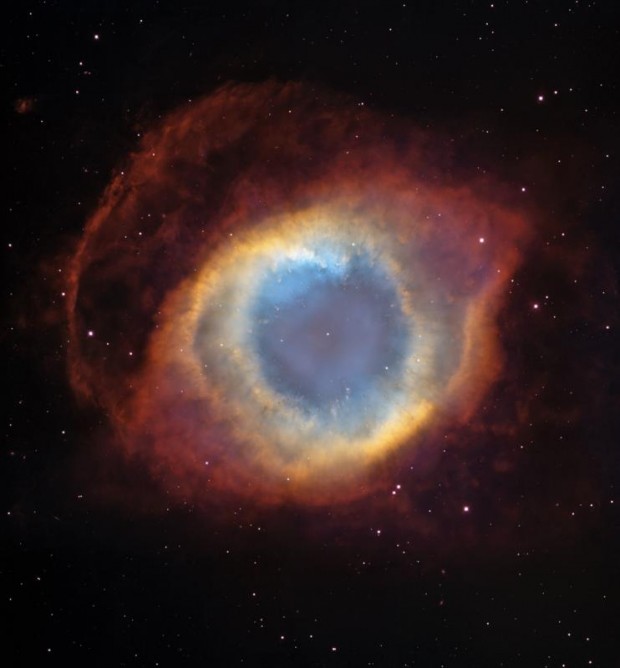
Image-source: NASA, ESA, C.R. O’Dell (Vanderbilt University), M. Meixner and P. McCullough (STScI)
Crab Nebula
This is a mosaic image, one of the largest ever taken by NASA’s Hubble Space Telescope of the Crab Nebula, a six-light-year-wide expanding remnant of a star’s supernova explosion. Japanese and Chinese astronomers recorded this violent event nearly 1,000 years ago in 1054.
The orange filaments are the remains of the star and consist mostly of hydrogen. The rapidly spinning neutron star embedded in the centre of the nebula is the dynamo powering the nebula’s interior bluish glow. The blue light comes from electrons whirling at nearly the speed of light around magnetic field lines from the neutron star.
Distance: 6,500 light-years away in the constellation Taurus.
- High-res version: Link
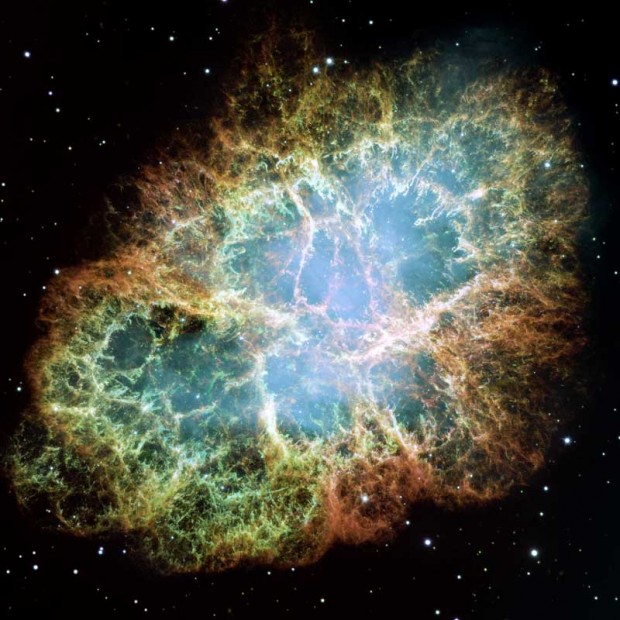
Image-source: NASA, ESA, J. Hester and A. Loll (Arizona State University)
Westerlund 2 – Gum 29 Nebula
The sparkling centrepiece of Hubble’s silver anniversary fireworks is a giant cluster of about 3,000 stars called Westerlund 2, named for Swedish astronomer Bengt Westerlund, who discovered the grouping in the 1960s.
Distance: 20,000 light-years away in the constellation Carina.
- High-res version: Link
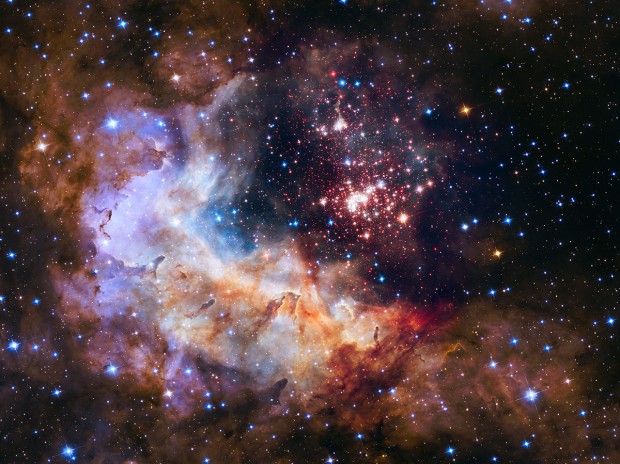
Image-source: NASA, ESA, the Hubble Heritage Team (STScI/AURA), A. Nota (ESA/STScI), and the Westerlund 2 Science Team
Hubble Panoramic View of Orion Nebula
An image from NASA’s Spitzer and Hubble Space Telescopes looks more like an abstract painting than a cosmic snapshot. The image shows the Orion nebula in an explosion of infrared, ultraviolet and visible-light colours.
At the heart is a set of four monstrously massive stars, collectively called the Trapezium. These behemoths are approximately 100,000 times brighter than our sun and can be identified as the yellow smudge near the centre of the composite.
This image is a false-colour composite, in which light detected at wavelengths of 0.43, 0.50, and 0.53 microns is blue. Light with wavelengths of 0.6, 0.65, and 0.91 microns is green. Light of 3.6 microns is orange, and 8-micron light is red.
Distance: 1,500 light-years away from Earth in the Orion nebula.
- High-res version: Link
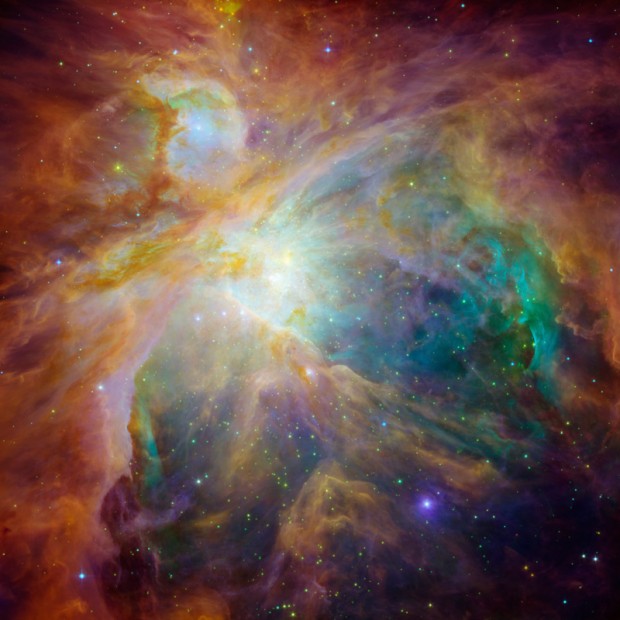
Image-source: NASA, ESA, T. Megeath (University of Toledo) and M. Robberto (STScI)
Tarantula Nebula
An image from NASA’s Hubble Space Telescope image of a stellar breeding ground in 30 Doradus, located in the heart of the Tarantula Nebula. The nebula resides 170,000 light-years away in the Large Magellanic Cloud, a small, satellite galaxy of our Milky Way. No known star-forming region in our galaxy is as large or as prolific as 30 Doradus.
Collectively, the stars in this image are millions of times more massive than our Sun. The image is roughly 650 light-years across and contains some rambunctious stars, from one of the fastest rotating stars to the speediest and most massive runaway star.
Distance: 170,000 light-years away in the Large Magellanic Cloud, a small satellite galaxy of our Milky Way.
- High-res version: Link
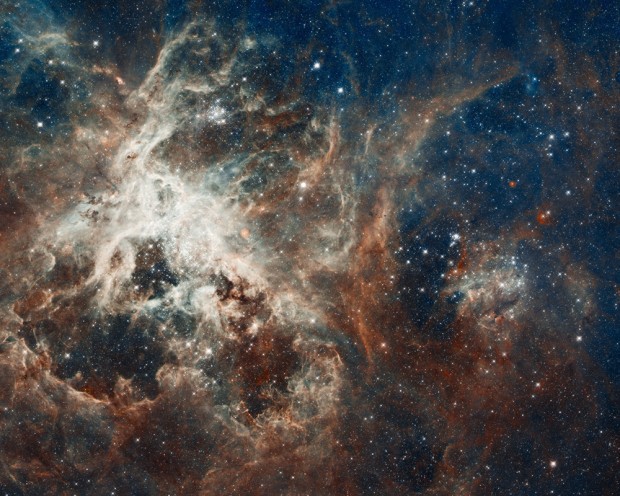
Image-source: NASA, ESA, D. Lennon and E. Sabbi (ESA/STScI), J. Anderson, S. E. de Mink, R. van der Marel, T. Sohn, and N. Walborn (STScI), N. Bastian (Excellence Cluster, Munich), L. Bedin (INAF, Padua), E. Bressert (ESO), P. Crowther (University of Sheffield), A. de Koter (University of Amsterdam), C. Evans (UKATC/STFC, Edinburgh), A. Herrero (IAC, Tenerife), N. Langer (AifA, Bonn), I. Platais (JHU), and H. Sana (University of Amsterdam)
Omega Nebula
This intense image shows a bubbly ocean of glowing hydrogen gas and small amounts of other elements such as oxygen and sulphur. This image captures a small region within M17, a hotbed of star formation.
The wave-like patterns of gas have been sculpted and illuminated by a torrent of ultraviolet radiation from young, massive stars, which lie outside the image to the upper left. The glow of these patterns accentuates the three-dimensional structure of the gases. The ultraviolet radiation is carving and heating the surfaces of cold hydrogen gas clouds. The warmed surfaces glow orange and red in this photograph. The intense heat and pressure cause some material to stream away from those surfaces, creating the glowing veil of even hotter greenish gas that masks background structures. The pressure on the tips of the waves may trigger new star formation within them.
Distance: 5,500 light-years away in the constellation Sagittarius.
- High-res version: Link
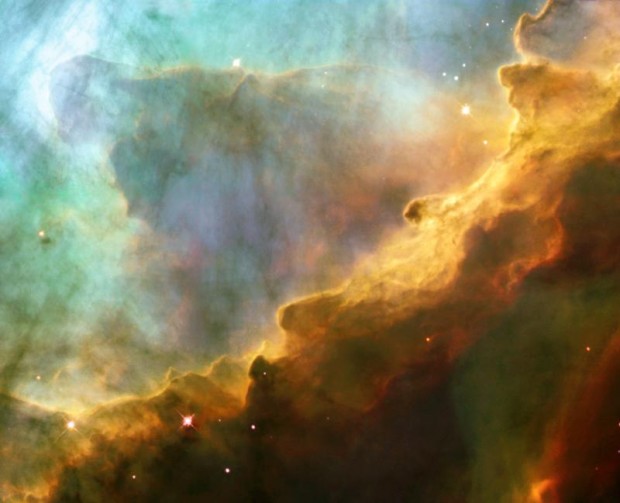
Image-source: Credit: NASA, ESA and J. Hester (ASU)
Shawn Hunt is the managing director of 1staerials.co.uk










